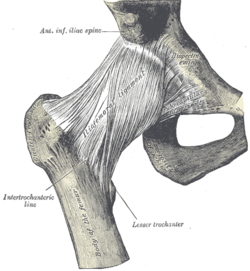Iliofemoral
| Iliofemoral | |
|---|---|

Right hip-joint from the front. (Iliofemoral ligament visible at center.)
|
|

Structures surrounding right hip-joint. (Iliofemoral ligament labeled at upper left.)
|
|
| Details | |
| From | ilium (anterior inferior iliac spine) |
| To | femur (intertrochanteric line) |
| Identifiers | |
| Latin | ligamentum iliofemorale |
| Dorlands /Elsevier |
l_09/12492337 |
| TA | A03.6.07.003 |
| FMA | 42993 |
|
Anatomical terminology
[]
|
|
The iliofemoral ligament is a ligament of the hip joint which extends from the ilium to the femur in front of the joint. It is also referred to as the Y-ligament (see below) or the ligament of Bigelow, and any combinations of these names.
With a tensile strength exceeding 350 kg (772 lbs), the iliofemoral ligament is not only stronger than the two other ligaments of the hip joint, the ischiofemoral and the pubofemoral, but also the strongest ligament in the human body and as such is an important constraint to the hip joint.
Arising from the anterior inferior iliac spine and the rim of the acetabulum, the iliofemoral ligament spreads obliquely downwards and laterally to the intertrochanteric line on the anterior side of the femoral head. It is divided into two parts or bands which act differently: the transverse part above, is strong and runs parallel to the axis of the femoral neck. The descending part below, is weaker and runs parallel to the femoral shaft. As the lateral portion is twisted like a screw, the two parts together take the form of an inverted Y.
It is intimately connected with the joint capsule, and serves to strengthen the joint by resisting hyperextension. Its upper band is sometimes named the iliotrochanteric ligament. Between the two bands is a thinner part of the capsule. In some cases there is no division, and the ligament spreads out into a flat triangular band which is attached to the whole length of the intertrochanteric line.
In a standing posture, when the pelvis is tilted posteriorly, the ligament is twisted and tense, which prevents the trunk from falling backwards and the posture is maintained without the need for muscular activity. In this position the ligament also keeps the femoral head pressed into the acetabulum.
...
Wikipedia
